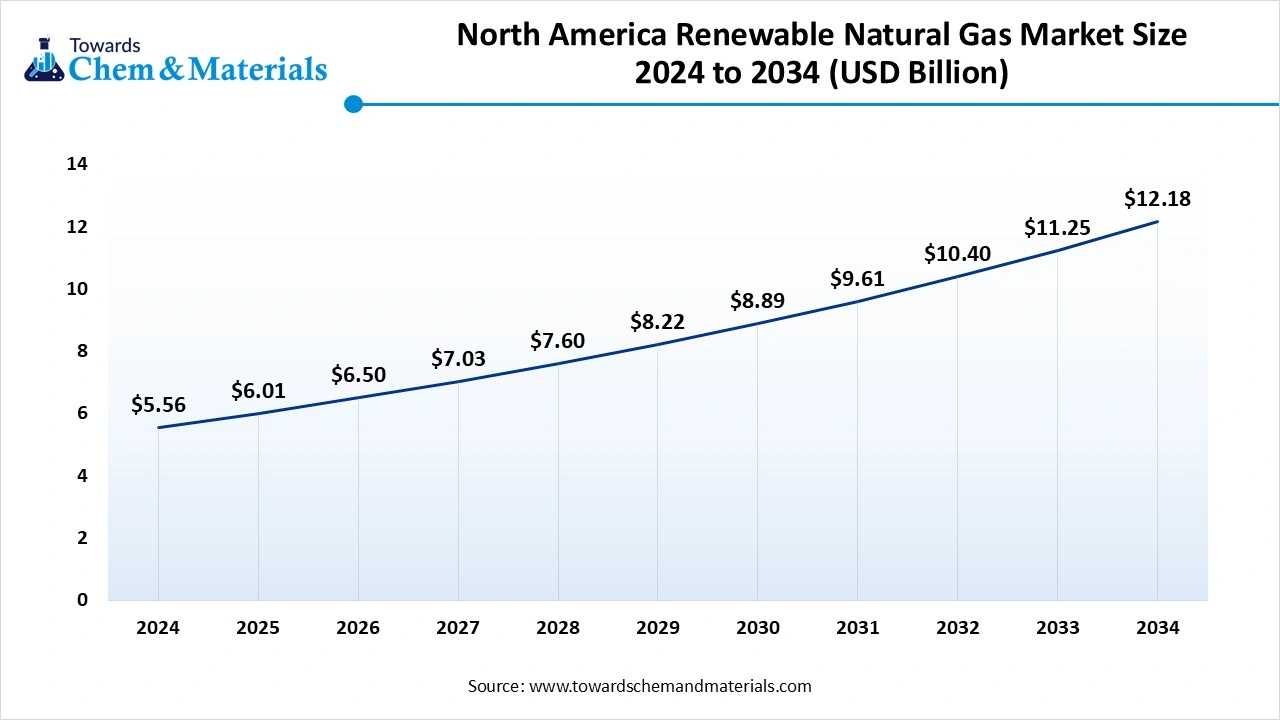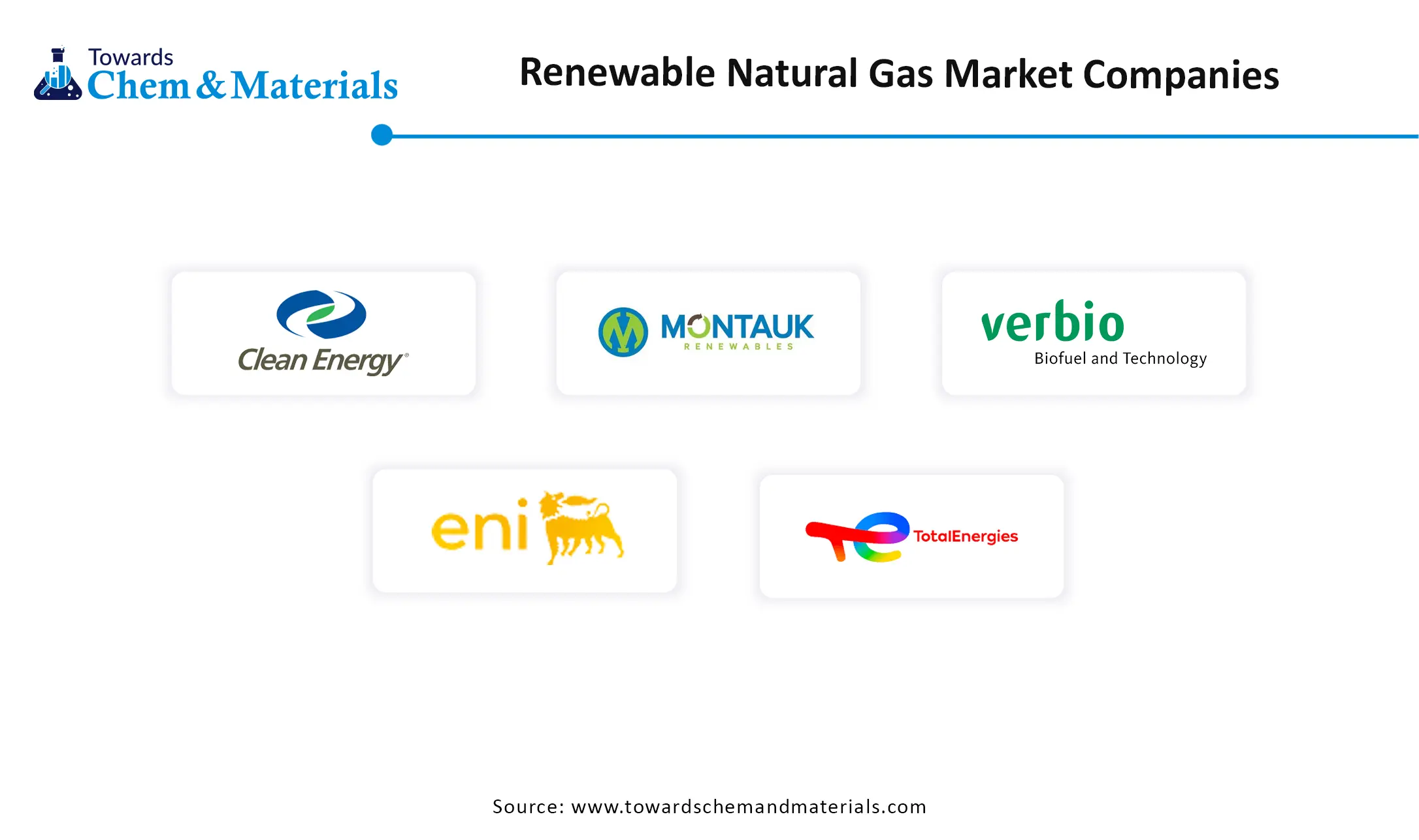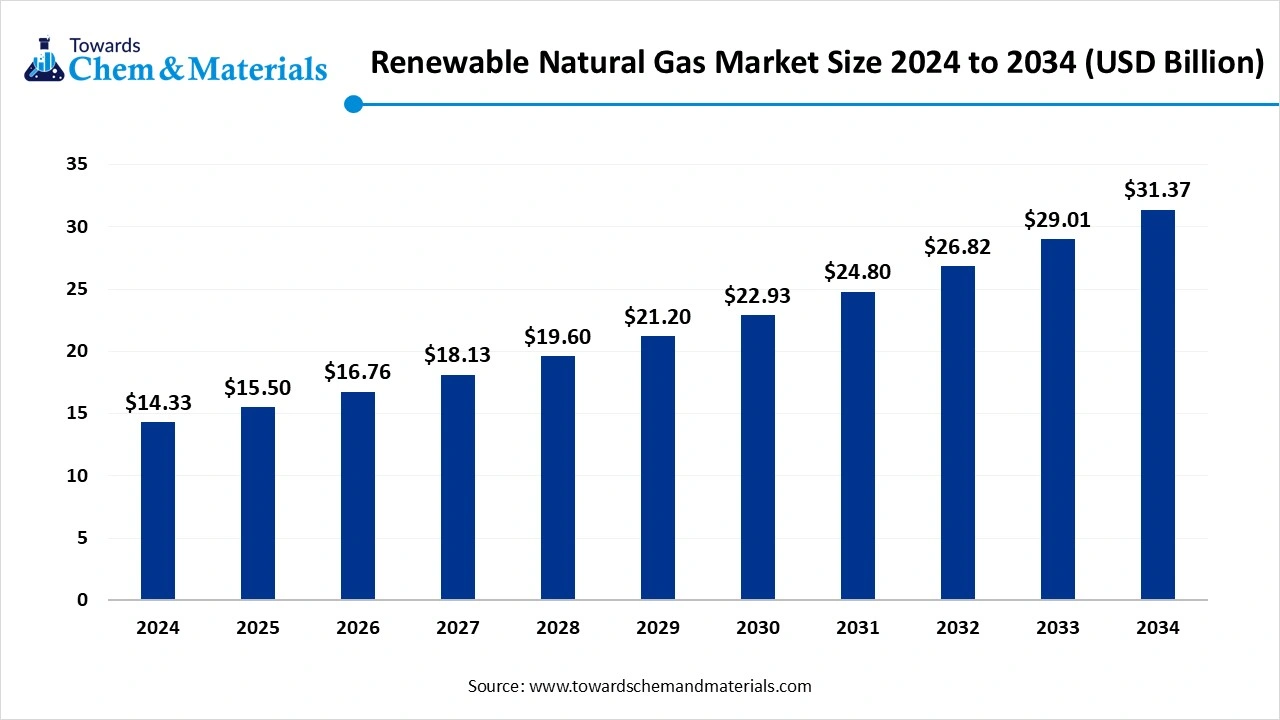Content
Renewable Natural Gas Market Size and Share 2034
The global renewable natural gas market size is calculated at USD 15.5 billion in 2025 and is forecasted to reach around USD 31.37 billion by 2034, accelerating at a CAGR of 8.15% from 2025 to 2034. Increasing environmental concerns around the world is the key factor driving market growth. Also, innovations in biogas production coupled with the rising application of alternative fuels in the transportation industry can fuel market growth further.
Key Takeaways
- By region, North America dominated the global renewable natural gas market with the largest share in 2024. The dominance of the region can be attributed to the robust pipeline network and distribution network across the region enabling smooth transportation of renewable gas.
- By region, Asia Pacific is expected to grow at a significant CAGR over the forecast period. The growth of the region can be credited to the growing demand to address greenhouse gas emissions.
- By feedstock, the landfill segment dominated the market in 2024. The dominance of the segment can be attributed to the strong availability of waste-based feedstock to convert it into renewable natural gas.
- By feedstock, the wastewater treatment segment is expected to grow at the fastest CAGR over the forecast period. The growth of the segment can be linked to the substantial economic and environmental benefits of RNG.
- By application, the vehicle fuel segment held the largest renewable natural gas market in 2024. The dominance of the segment can be credited to the substantial economic and environmental benefits of renewable natural gas in vehicles.
- By application, the power generation segment is expected to grow at the fastest CAGR during the projected period. The growth of the segment can be driven by a growing emphasis on energy security, environmental sustainability, and economic development.
The Surge in the Application of Alternative Fuel is Expanding Market Growth
The market covers the production, distribution, and sale of gas obtained from renewable sources. Mainly it's a biogas that has been processed to fulfil the standards of conventional natural gas, which makes it usable and interchangeable in existing natural gas infrastructure like vehicles. RNG can be produced from different waste materials such as landfill gas, agricultural waste, and wastewater treatment plant byproducts. RNG production can reduce greenhouse gas emissions with trapping methane which can easily get released into the environment from decomposing organic matter. Governments are offering fiscal incentives, tax reliefs, and subsidies to improve total RNG production.
What are the Key Trends Influencing the Renewable Natural Gas Market?
- Innovations in technology utilized to capture methane, and upgrade biogas and waste-to-energy technology are enhancing the production of RNG. The technologies are enabling more economical manufacturing and competition as fossil fuel-based traditional natural gas.
- Consumers across the globe are increasingly becoming aware of the bad consequences of fossil fuels and climate change. This demand further increases the clean energy sources like RNG. Low-carbon fuel policies, renewable energy mandates, and carbon tax programs are propelling the production and consumption of RNG.
- Ongoing collaboration among the agricultural cooperatives and farmers is also the latest trend fuelling the market growth. Such collaboration helps renewable gas projects address the crucial challenges of securing an eco-friendly feedstock supply. This also boosts synergies between various industries. Such models can boost renewable gas production volumes across the globe.
How is the Government Supporting the Renewable Natural Gas Market?
The Indian government is supporting the market through various initiatives and policies such as the Gobardhan initiative, SATAT scheme, and blending mandates. These efforts aim to minimize import reliance on crude oil, support cleaner energy sources, and create a circular and more sustainable economy. SATAT emphasizes strengthening Compressed Biogas (CBG) production to make CBG available for use in automobile fuels.
The US government is promoting the market through different financial mechanisms and policies, like incentives, tax credits, and mandates. The Renewable Fuel Standard (RFS) program mandates the utilization of renewable fuels like RNG in the transportation sector, creating market opportunities in the country further. Moreover, several states including Oregon, Washington, and California have implemented Low Carbon Fuel Standards (LCFS) that incentivize RNG production.
Report Scope
| Report Attributes | Details |
| Market Size in 2025 | USD 15.5 Billion |
| Expected Size by 2034 | USD 31.37 Billion |
| Growth Rate from 2025 to 2034 | CAGR 8.15% |
| Base Year of Estimation | 2024 |
| Forecast Period | 2025 - 2034 |
| Dominant Region | North America |
| Segment Covered | By Feed Stock, By Application, By Region |
| Key Companies Profiled | Clean Energy Fuels Corp. (United States), Montauk Renewables, Inc. (United States), VERBIO Vereinigte BioEnergie AG (Germany) , Eni S.p.A. (Italy), TotalEnergies SE (France) , BP plc (United Kingdom) , Engie SA (France) , Orsted A/S (Denmark) , Technip Energies N.V. (France) , VARO Energy (Switzerland) , Gazprom PJSC (Russia) , FortisBC Energy Inc. (Canada) , Dominion Energy, Inc. (United States) |
Market Opportunity
Integration of RNG into Natural Gas Infrastructure
The market is experiencing a substantial trend towards the integration of RNG into current natural gas infrastructure, optimizing a smooth shift towards cleaner energy sources. This integration also enables the convenient distribution and use of RNG across various industries like commercial, residential, and industrial Furthermore, regulatory support boosts the public awareness of sustainability increases, as more stakeholders are adopting this solution, fuelling innovations and investment in the sector.
In March 2025, the American Biogas Council announced it had introduced its biogas carbon accounting tool, a robust tool to measure the full lifecycle emissions of biogas plants. The new tool was built for the ABC by EcoEngineers, a major energy auditing, consulting, and advisory firm.(Source: biomassmagazine)
Market Challenge
Inconsistent Feedstock Availability and Cost
RNG production depends on organic waste streams like municipal, agricultural, etc, as feedstock. The consistent supply and availability of these feedstocks can be a hurdle, especially in certain regions. Hence, managing transportation costs and securing reliable feedstock supply chains are important for cost-effective RNG production. Moreover, Establishing RNG production facilities like storage, digesters, and pipelines needs a substantial upfront capital expenditure, hindering market growth further.
Regional Insight
The North America renewable natural gas market size is calculated at USD 6.01 billion in 2025 and is projected to surpass around USD 12.18 billion by 2034, expanding at a CAGR of 8.16% from 2025 to 2034. North America dominated the renewable natural gas market in 2024.

The dominance of the region can be attributed to the robust pipeline network and distribution network across the region enabling smooth transportation of renewable gas. In addition, Canada and the United States have experienced a substantial surge in RNG development, propelled by their strong natural gas infrastructure, rising commitment to decarbonization, and conducive policy frameworks.
Renewable Natural Gas Market in U.S.
In North America, the U.S. led the market owing to the growing awareness of climate change along with sophisticated government policies. Federal and state policies such as California's Low Carbon Fuel Standard and Renewable Fuel Standard play a significant role in fuelling this adoption. Also, RNG production from sources such as livestock operations, landfills, and wastewater treatment plants provides an eco-friendly alternative for waste management.
- In January 2025, Pilgrim's Pride launched the SC renewable natural gas project. This project is anticipated to reduce greenhouse gas emissions and enhance overall water and air quality. The project was unveiled at Pilgrim's poultry processing setting in South Carolina.(Source: wattagnet)
Asia Pacific is expected to grow at the fastest CAGR over the forecast period. The growth of the region can be credited to the growing demand to address greenhouse gas emissions and air quality concerns in developing countries. Furthermore, emerging economies such as China, Japan, and South Korea are increasingly exploring RNG as a means to shift away from fossil fuels and improve air quality standards.

Renewable Natural Gas Market in China
In the Asia Pacific, China dominated the market in 2024, by holding the largest market share, due to the growing need for clean energy and supportive government policies. Additionally, China has big renewable energy targets, hence RNG can play a significant role in minimizing dependence on fossil fuels and diversifying the energy mix. Hence natural gas consumption in China is increasing, generating lucrative opportunities for renewable and conventional sources.
Who are the Top 5 Biggest Renewable Energy Companies in the World by Revenue in 2024?
| Company | Revenue |
| Iberdrola SA (IBDRY) | $50.68 billion |
| GE Vernova (GEV) | $33.67 billion |
| NextEra Energy (NEE) | $27.13 billion |
| Constellation Energy Corp. (CEG) | $23.51 billion |
| Vestas Wind Systems A/S (VWDRY) | $16.58 billion |
(Source:investopedia )
Segmental Insight
Feedstock Insight
Which Feedstock Segment Dominated the Renewable Natural Gas Market in 2024?
The landfill segment dominated the market in 2024. The dominance of the segment can be attributed to the strong availability of waste-based feedstock to convert it into renewable natural gas. Landfills receive large amounts of municipal solid waste, via anaerobic digestion, generates biogas, primarily methane. In addition, advancements in gas collection and treatment methods are improving the quality and efficiency of landfill gas utilization, which makes it a more attractive choice.
- In June 2025, EQT stepped into negotiations with the plan of taking Waga private. The firm is looking at its investment as crucial to boost Waga's position in the renewable natural gas market.(Source: wastedive)
The wastewater treatment segment is expected to grow at the fastest CAGR over the forecast period. The growth of the segment can be linked to the substantial economic and environmental benefits of RNG.RNG production can substantially minimize methane emissions, a harmful gas responsible for global warming. In addition, wastewater treatment plants can create revenue by selling the RNG they produce, presenting new income streams.
Application Insight
Why Did Vehicle Fuel Segment Dominated the Renewable Natural Gas Market in 2024?
The vehicle fuel segment held the largest market share in 2024. The dominance of the segment can be credited to the substantial economic and environmental benefits of renewable natural gas in vehicles. RNG vehicles generate fewer harmful emissions such as nitrogen oxides, carbon monoxide, and particulate matter, contributing to cleaner air, particularly in urban areas. Moreover, this adoption is generally high in heavy-duty applications, like trucks and buses where RNG has demonstrated its ability to substantially curtail emissions.
The power generation segment is expected to grow at the fastest CAGR over the forecast period. The growth of the segment can be driven by a growing emphasis on energy security, environmental sustainability, and economic development. RNG obtained from biogas can be utilized in existing natural gas power plants, providing a cleaner energy source as compared to fossil fuels, while contributing to job creation and waste management.
Recent Developments
- In September 2024, The European Commission launched a consultation on a draft methodology for low emissions of carbon and hydrogen. The secondary legislation is needed under the revised EU gas and hydrogen market legislation that stepped into force over the summer.(Source: energy.ec.europa.eu)
- In April 2025, Ares Management launched the latest renewable natural gas platform called Sagepoint Energy, which brings together various assets with a plan for expansion. The company is also planning to carry on its portfolio of landfill projects.(Source: wastedive)
Top Companies List

- Clean Energy Fuels Corp. (United States)
- Montauk Renewables, Inc. (United States)
- VERBIO Vereinigte BioEnergie AG (Germany)
- Eni S.p.A. (Italy)
- TotalEnergies SE (France)
- BP plc (United Kingdom)
- Engie SA (France)
- Orsted A/S (Denmark)
- Technip Energies N.V. (France)
- VARO Energy (Switzerland)
- Gazprom PJSC (Russia)
- FortisBC Energy Inc. (Canada)
- Dominion Energy, Inc. (United States)
Segments Covered
By Feed Stock
- Landfill
- Wastewater Treatment
- Agricultural Waste
- Others
By Application
- Vehicles Fuel
- Power Generation
- Pipeline Injection
- Others
By Region
- North America
- U.S.
- Canada
- Europe
- Germany
- UK
- France
- Italy
- Spain
- Sweden
- Denmark
- Norway
- Asia Pacific
- China
- Japan
- India
- South Korea
- Thailand
- Latin America
- Brazil
- Mexico
- Argentina
- Middle East and Africa (MEA)
- South Africa
- UAE
- Saudi Arabia
- Kuwait
- Report Covered: [Revenue + Volume]
- Historical Year: 2021-2023
- Base Year: 2024
- Estimated Years: 2025-2034

